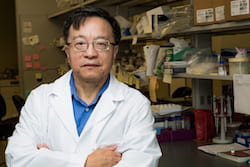EXPERT ALERT
Jeff Falk
713-348-6775
jfalk@rice.edu
Mike Williams
713-348-6728
mikewilliams@rice.edu
Bioengineer Gang Bao available to comment on gene editing-based strategy to halt disease
HOUSTON – (June 16, 2021) – A Rice University professor involved in the search for a way to treat and perhaps cure sickle cell disease is available to comment on a major advance revealed today in Science Translational Medicine.
Rice University bioengineer Gang Bao is a pioneer in sickle cell research and a co-author of the breakthrough study released today led by his colleagues at Stanford University.
Sickle cell disease, which affects about 100,000 Americans and millions worldwide, is a painful and often fatal inherited condition. A single mutation in hemoglobin subunit beta (aka beta-globin) forces normal, disc-shaped red blood cells to stiffen and take characteristic “sickle” shapes. These sticky, crescent-shaped cells can damage vessel walls and clot small blood vessels, stopping the delivery of oxygen to tissues.
The international team of researchers reported on the successful gene correction in hematopoietic stem and progenitor cells (HSPCs) from patients with sickle cell disease in a preclinical study, as well as 20% gene correction after transplantation of gene-edited HSPCs into immunodeficient mice. The team used CRISPR-Cas9 “nanoscissors” to fix the mutation that causes the body to make sickle cells.
The hope is that corrected stem cells injected into a patient, through a process known as engraftment, will survive and proliferate, replacing mutant stem cells to curtail or even eliminate the painful disease.
“This study was designed to lead to a phase one clinical trial, which has now been approved,” said Bao, chair of Rice’s Department of Bioengineering whose team designed the CRISPR-based guide RNA system used in the research and tracked off-target edits that were determined to be of limited risk.
“The primary significance of this work is that the engraftment rate increased roughly four-fold,” he said. “If you deliver cells to patients after editing and most of the cells die, then efficacy will be very low. So any improvement is a major advance.”
He said damaging mutant stem cells through chemotherapy or radiation before injecting gene edited cells either into the bloodstream or directly into bone marrow will improve their chance of proliferating. That strategy is the focus of many efforts to halt sickle cell disease, including the Stanford study and a separate study at Rice.
To arrange an interview with Bao, the Foyt Family Professor of Bioengineering and a professor of chemistry and of materials science and nanoengineering, contact Mike Williams at mikewilliams@rice.edu or 713-348-6728.
-30-
Read the abstract at https://stm.sciencemag.org/content/13/598/eabf2444.
Follow Rice News and Media Relations via Twitter @RiceUNews.
Related materials:
Rice wins federal grant to advance sickle cell disease therapy: http://news.rice.edu/2020/04/24/rice-wins-fed-grant-to-advance-sickle-cell-disease-therapy-2/
Rice U. reports progress in pursuit of sickle cell cure: http://news.rice.edu/2018/02/16/rice-u-reports-progress-in-pursuit-of-sickle-cell-cure-2/
New genetic weapons challenge sickle cell disease: http://news.rice.edu/2019/06/03/new-genetic-weapons-challenge-sickle-cell-disease-2/
Laboratory of Biomolecular Engineering and Nanomedicine (Bao lab): http://bao.rice.edu/index.html
Department of Bioengineering: https://bioengineering.rice.edu
Image for download:
https://news2.rice.edu/files/2021/06/0616_SICKLE-1-WEB.jpg
CAPTION: Gang Bao. (Credit: Jeff Fitlow/Rice University)
Located on a 300-acre forested campus in Houston, Rice University is consistently ranked among the nation’s top 20 universities by U.S. News & World Report. Rice has highly respected schools of Architecture, Business, Continuing Studies, Engineering, Humanities, Music, Natural Sciences and Social Sciences and is home to the Baker Institute for Public Policy. With 3,978 undergraduates and 3,192 graduate students, Rice’s undergraduate student-to-faculty ratio is just under 6-to-1. Its residential college system builds close-knit communities and lifelong friendships, just one reason why Rice is ranked No. 1 for lots of race/class interaction and No. 1 for quality of life by the Princeton Review. Rice is also rated as a best value among private universities by Kiplinger’s Personal Finance.


